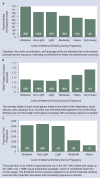Prenatal Alcohol Exposure and Neurobehavioral Development: Where Is the Threshold?
- PMID: 31798162
- PMCID: PMC6876482
Prenatal Alcohol Exposure and Neurobehavioral Development: Where Is the Threshold?
Abstract
In terms of prenatal alcohol-induced alterations in neurobehavioral outcomes such as attention, activity level, and information-processing speed, a threshold of alcohol consumption may be difficult to determine. Studies on humans indicate that seven standard drinks per week may be the threshold for the most sensitive neurobehaviors but may not apply to all women and all babies.
Figures


References
-
- Barr HM, Streissguth AP, Darby BL, Sampson PD. Prenatal exposure to alcohol, caffeine, tobacco, and aspirin: Effects on fine and gross motor performance in 4-year-old children. Developmental Psychology. 1990;26(3):339–348.
-
- Colombo J, Mitchell DW, Coldren JR, Freeseman LJ. Individual differences in infant visual attention: Are short lookers faster processors or feature processors? Child Development. 1991;62:1247–1257. - PubMed
-
- Ernhart CB, Sokol RJ, Ager JW, Morrow-Tlucak M, Martier S. Alcohol-related birth defects: Assessing the risk. Annals of the New York Academy of Sciences. 1989;562:159–172. - PubMed
-
- Greene T, Ernhart CB, Sokol RJ, Martier S, Marler MR, Boyd TA, Ager JA. Prenatal alcohol exposure and preschool physical growth: A longitudinal analysis. Alcoholism: Clinical and Experimental Research. 1991;15(6):905–913. - PubMed
-
- Haith MM, Hazan C, Goodman GS. Expectation and anticipation of dynamic visual events by 3.5-month-old babies. Child Development. 1988;59:467–479. - PubMed
LinkOut - more resources
Full Text Sources
